North Carolina War Between the States Sesquicentennial
North Carolinians Among the "Immortal 600"

Memorial at Fort Pulaski Near Savannah
In mid-1864 Northern forces had laid siege to the city of Charleston after obtaining a foothold on Morris Island.
From this point artillery batteries had been erected in order to throw shells not only toward Forts Sumter
and Moultrie, but also the city itself and its noncombatants. This bombardment recalled the April, 1780 siege
of Charleston by British and Hessian forces and was the primary reason why Forts Sumter and Moultrie
were erected in the post-Revolutionary period – to defend Charleston from enemy attack from the sea.
The three highlighted paragraphs below describe the British-Hessian bombardment of Charleston in 1780. Ironically,
soldiers in the invading Northern forces were of German birth and posibly descendants of the earlier Hessian invaders.
Note:
Please see the website www.600csa.com for more information about the Immortal Six Hundred.
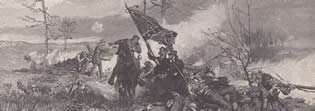
North Carolinians of “The Immortal 600”
“Obsessed with the reduction and capture of Charleston, the Northern commander in May 1864, the fourth
in four years who tried to capture the city, planned a massive artillery bombardment to force its capitulation.
His five-pronged attack which coordinated land and sea forces in late June ended in failure, capped by a
Southern counterattack which nearly annihilated the attackers, being saved from this by Northern
gunboats covering the retreat.
“At 10 o’clock in the morning of [April 13, 1780] our batteries began to play violently and seriously
on the city, and this fire was answered just as violently by the enemy. It lasted without interruption until
eight o’clock in the evening. Also, firebombs were shot into the city today, because of which the city, and,
indeed, the house of the governor and of the commanding officer were set on fire as soon as these
bombs began to be used. The Hessian artillery fired the fire-bombs. The enemy works suffered great
damage today, and several of their cannons were dismounted.
(The 1780 Siege of Charleston as Experienced by a Hessian Officer)

General Sam Jones
Commander, South Carolina District
Beyond bombarding Fort Sumter, Northern shells were being thrown indiscriminately into residential
areas of the city. It was claimed that Charleston was a “depot for military supplies, munitions factories and
foundries for war materiel,” and though Charleston’s commander, Major-General Sam Jones, sent
communiqués indicating the presence of non-combatants in the residential sections of the city.
Further, 50 high-ranking Northern officers were quartered in the home owned by
Colonel James O’Conner, what is now 180 Broad Street. These were five generals, forty-five colonels,
lieutenant-colonels, and majors who had arrived in early June. They had been in Charleston when
the increase of bombardment began.
"On the 14th the cannon fire was moderate on both sides. At noon we received news that the
Cathcart Legion and Ferguson’s Corps had attacked a corps of rebels thirty miles from here between
the Cooper and Ashley rivers and captured a hundred prisoners, including three officers, and almost
as many horses. A reinforcement arrived from New York. This consisted of the regiment von Ditworth,
the 42nd Scots Regiment, the Queen’s Rangers, Lord Rawdon’s Corps, and Colonel Brown’s Corps."
(The 1780 Siege of Charleston as Experienced by a Hessian Officer)
Hoping to appeal to the Northern sense of honor and humanity, General Jones notified his opponent
in August that no military targets were located in that residential area of the city. The reply was
“Charleston must be considered a place of arms…In reference to the women and children of the bombarded city,
I therefore can only say the same situation occurs whenever a weak and strong party are at war.”
General Jones was shocked by the reply and determined that this was simply “a threat to destroy
a civilian city in a dishonorable attempt to force a surrender.”
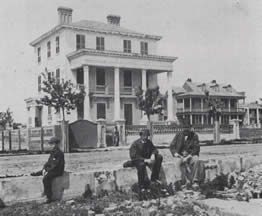
O'Conner House Where Northern Officers Were Held
Jones noted that only civilians were being harmed and killed while those manning the batteries that
would be considered military targets went about their business without drawing the fire of Northern artillery.
"The besieged in Charleston were now cut off from land on all sides [and] we became absolute masters
of the river. On the [May] 7th our siege was continued…Our jaegers caused great damage to the
enemy in the city….a battery did great and constant damage to the houses in the city…
The fire from this battery distinguished itself through the repeated pauses of all other batteries,
and it was not seldom that these Jacktars gave a full broadside.”
(The 1780 Siege of Charleston as Experienced by a Hessian Officer)
As a form of retaliation for Northern officers being in Charleston, fifty imprisoned Confederate officers
were “placed under fire…placing twelve to fifteen officers in the barracks to be constructed in each of the
Union forts, thus protecting the whole Union force on Morris Island.”
To underscore the non-combatant area of Charleston in which they were quartered, the five Northern generals
in Charleston sent a letter to the Northern commander that “[We] at this time, are as pleasantly and comfortably
situated as is possible for prisoners of war, receiving from the Confederate authorities every privilege that we
could desire or expect, nor are we unnecessarily exposed to fire.”
More Southern officers were sent as hostages from Fort Delaware prison, to include Brigadier-Generals
Basil Duke and Franklin Gardner, and Lieut.-Col. Marshall J. Smith. On August 20, six-hundred Southern officers
of all ranks we sent to Morris Island about the steamer Crescent City to be held in an open stockade in front
of the Northern batteries.
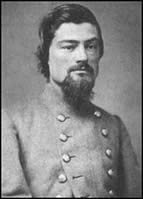
General Basil Duke
Captain John C. Gorman [Wilson County] of the 2nd North Carolina Regiment wrote that “We were packed as thick as we
could lie [below decks]…it was a perfect hell, and nearly as hot. The water that was given us was impure, and
some times the stomach would refuse it from its putrid smell. They fed us twice daily, on crackers and raw bacon.”
Other prisoners stated that “at one time we had no water for forty hours…We were almost famished, provisions
and water having given out two days before we reached Hilton Head.
Captain Walter MacRae of the 7th North Carolina Regiment wrote: “On the 7th of September we disembarked
at Morris Island and when we finally came out into the light of day and had a look at one another we were
astonished to note the ravages made by the terrible heat and the nauseous confinement. One could scarcely
recognize his best friends. There were six of us from Wilmington…all badly damaged.”
The rumors of the officers being put in the line of fire had become fact as they saw the stockade pen and had
never thought that a civilized nation would use prisoners as human shields. They would be held there for forty-five
days with artillery fire from their own batteries screaming over their heads and threatening immediate death.
Additionally, a battery of Billinghurst-Requa machine guns were trained on the camp in case the
prisoners became unruly.
A North Carolina Colonel and veteran of the Mexican War, John Lucas Cantwell of the 51st and 3rd North Carolina
Regiments became the official historian of the 600 while confined on Morris Island. He recorded and noted the
sick and wounded, and gathered names and units of the prisoners.

Colonel John Lucas Cantwell
On the evening of September 9th an artillery duel between Morris Island and Fort Moultrie occurred, and
most of the firing would be at night. The gunners at Moultrie fired well but occasionally a shell would
burst overhead and scatter fragments in the camp. The greatest danger to the prisoners came from the
Northern batteries behind them as shells fired could burst prematurely – and throw huge shrapnel into the
camp. After one of these incidents a horse was killed by fragments and a man’s leg sliced off.
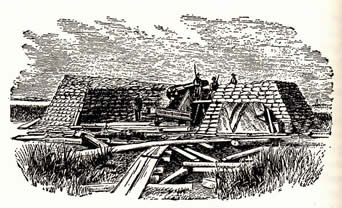
Northern Siege Gun, the "Swamp Angel"
One night “the whole heavens were illuminated and the mortar shells were darting through the heavens
in all directions as though the sky was full of meteors."
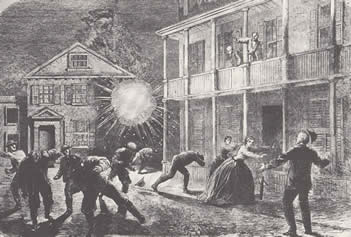
On September 10, General Jones in Charleston wrote the Northern commander that he had received
word that numerous Confederate officers were under fire from Sumter “because I believe you are
retaliating on those officers for a supposed disregard of the usages of civilized warfare in the
treatment extended to U.S. officers, prisoners of war, now in this city. Those officers are comfortably
housed and receive the treatment due prisoners of war.” He urged his opponent to bring his actions
within the confines of accepted rules of war.
Though the Northern officers in Charleston had little complaint of their prison fare of fresh meat, rice,
bread, meal and beans, the rations accorded the Confederate officers would barely sustain life.
Captain MacRae recored that “Some of the prisoners for the sake of the record complained to the
[Northern] colonel. He replied that it was all right; there was meat enough in the meal, bugs and worms,
and that if he had his own way he would be only too glad to feed us on greasy rags.” A Virginia captain
wrote about “the amount of dead animal matter in the shape of white worms, which was the mush given us.”
Another said they received “one-half pint bean soup, two crackers, wormy and full of bugs. Rations for
supper, two ounces of bacon, two crackers, wormy as usual.” The daily ration would change about three
weeks later, altered to one-quarter of the previous amount – resulting in severe weakness and intestinal
disorders in the prisoners. Water ration was cut as well, and the men began to catch rain or dig for water.
A Virginia officer said “they are starving us by degrees.”
After being under fire for three weeks, the first prisoner died – of starvation. Lt. William P. Callahan
of the 25th Tennessee cavalry officially died from chronic diarrhea and was buried at Morris Island.
On October 2, 1864, Lt. Frank Peake died of the same –a condition brought on by poor diet and
unsanitary living conditions. Passing from a wound that his diet could not help heal as well as
pneumonia, was twenty-two year-old John C.C. Cowper of the 33rd North Carolina Regiment.
He had been wounded and captured at Gettysburg over a year before.
Due to an outbreak of yellow fever in Charleston in late September, General Jones was forced to move
his Northern prisoners to safety in Columbia. He notified Morris Island on October 13 that no
Northern officers were confined in Charleston, though this was ignored and the shelling of the city
intensified. With retaliatory fire from the Charleston batteries replying in kind, many Northern troops
abandoned the prisoners inside the pen. Unmoved that their indiscriminate firing was killing civilians,
Northern gunners threw a shell into the city every fifteen minutes.

At the end of October the authorities in Washington ordered an end to the bombardment of Charleston and
Northern troops were to take up defensive positions instead. From their original number of 600 upon
departing Fort Delaware, they now numbered five-hundred forty-nine – and had been under fire in their
stockade for forty-five days.
The six-hundred were moved on to transports and taken to Fort Pulaski at the mouth of the Savannah River.
Here they experienced more civilized guards and rations, though an early winter and exposure broke the
health of many officers – many caught colds and pneumonia. Many others had yet to recover from the
unsanitary conditions at Morris Island and long-term effects of the poor diet.
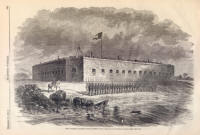
Fort Pulaski
Though food rations had improved, Christmas arrived and found many in the depths of depression,
tired of hoping for exchange or parole. It was too cold to walk around the prison barracks to relieve the
monotony. A Virginian noted that “Our rations are worse now than ever, our bread rations are being cut
down still lower and a few pickles being given us, which only increases our appetites for food which we
are not allowed to have. We have suffered most intensely from the cold during the last few days.”
Captain J. Ogden Murray of the 11th Virginia Cavalry wrote “I recall the dreadful sights and misery in that
Fort Pulaski prison – loved comrades starving to death, dying with that terrible disease scurvy, and the great
government of the united States responsible for all this wanton cruelty; and yet no effort was made to alleviate
or curtail it. Who will ever forget grand old Capt. John Lucas Cantwell – Gentle, kind, true…One thing that often
impressed me was the heroic conduct of our men under the ordeal…some of our comrades would…sing the
old familiar songs of the South, seeming for a time to forget the pains of retaliation and their hunger.”
Josyln writes or the physical result of their long confinement, starvation diet and physical deterioration:
“Young men, once vigorous, lay prostrate with the diseases of old age – rheumatism, pneumonia, and bronchitis.
The sound of coughing and labored breathing filled the room, disturbing the sleep of all. Scurvy and dysentery
existed in the extreme, causing debility and making life unendurable. In advanced stages, as many officers had it
by the end of January 1865, scurvy symptoms are similar to those of hemophilia. The blood vessels simply
disintegrate, spilling blood into the body. The joints are particularly affected, as the blood swells them and
prevents movement, causing excruciating pain. Most become blind to some degree, their palid faces like
ghosts from the anemia induced by scurvy. In the harsh conditions they clung
to each other for comfort, suffering patiently.”
Captain Murray of Virginia recalled “When the wolf, hunger, takes hold of a man, all that is human in the
man disappears. He will, in his hunger, eat anything. It is impossible to explain how we lived through
the terrible ordeal of fire and starvation. Those were horrible days – days which most thoroughly convince
me that nothing but actual experiment can determine how much starvation, hunger,
and bad treatment a human being can stand.”
Another Virginian wrote on January 2, 1865: “Yesterday…was the coldest day of the winter, which the
Yanks celebrated by refusing to furnish any wood. All day and all night many of us walked to keep up
the circulation, or shivered in our scanty covering. It was so cold that the boys who had no blankets had
to walk all night to keep from freezing.”
Capt. Henry Dickinson of the 2nd Virginia Cavalry wrote on February 1, 1865:
“On the 28th inst. Lieutenant [John M.] Burgin, of [the 22nd ] North Carolina, died from dysentery
at the hospital. Over 100 men are now sick, and scurvy in its worst form is among us…the scurvy sores
on the bodies of those around me are terrible sights.”
Many of the six hundred were shipped north and re-imprisoned at Fort Delaware in mid-March 1865.
At the ship’s arrival, seventy-five could not walk and had to be carried ashore – and many were
emaciated and near death after the sea journey from Georgia.
Adjutant Francis A. Boyle, 32nd North Carolina Regiment wrote on Wednesday, 15 March 1865:
“Their sufferings have been awful. By way of retaliation they were kept upon one pint of miserable wormy sour meal
and pickles per day for 45 days. Some actually starved to death upon this diet. Many others have been afflicted
with scurvy in its worst form, some still dying from its effects, and all whom I have seen show their bad treatment
plainly. At one time half their number were unable to rise from their beds. This diet was continued even after
many had been sent to the hospital in little better than a dying condition…”
After the fall of Richmond and Lee’s surrender at Appomattox in early April, many of survivors discussed
how the Northern government would treat them – as traitors and face execution? As expected, most would
refuse an oath of allegiance to what they considered a foreign government. They had reached a point where
they no longer had a country. But to many, “swallowing the dog” would release them to walk the long journey
home to family and hearthside
After Lincoln’s assassination reached Fort Delaware, the guards became mad and vindictive and
prisoners wondered “how many Southern lives it would take to appease the wrath and vengeance of the North.”
The prisoners were refused mail and word was passed that any sign of joy at Lincoln’s death would result
in immediate execution. As usual, boxes of goods sent to the prisoners by family and friends would be confiscated
and used by prison officials.
In late April and early May prisoners were repeatedly requested to take an oath of allegiance to the Northern
government, despite their sworn oaths to their home States. By the end of May and the life of the Confederate
government ebbing, and sensing their duty was to be home supporting their families and farms, only 161 of 2300
officers held in Fort Delaware refused the oath. Those that refused would continue imprisoned with sickness
and starvation their companion – and struggle with the thoughts of being home with their loved ones.

Fort Delaware
Most of the prisoners had taken the oath by June 1865 and all captains and lieutenants allowed to leave. No provision
for transportation was allowed and the sick, emaciated figures left the cold walls of the prison for the long walk home.
Colonel Tazewell Hargrove of the 44th North Carolina Regiment had steadfastly refused the oath as did
the remaining field-grade Confederate officers still held. After a letter from home from his father and a compatriot,
Hargrove and the rest relented after General Lee’s instructions to take the oath and help rebuild the devastated South.
He and the others were released on 24 July 1865.
After war’s end, John Lucas Cantwell returned to Wilmington and in 1866 formed the first organization of
Southern veterans -- the 3rd North Carolina Infantry Association. Fellow Wilmingtonian Captain Walter MacRae
later applauded Cantwell’s actions with this:
“the many attempts at escapes, always betrayed, the sickness, the wounds, the deaths, the organized efforts
for mutual help…are they not written and minutely set forth in Col. John L. Cantwell’s book of statistics and
notes which he began to collect from the start…even to the present day and which he preserved….Heaven
knows how, amid all the chances and changes of our prison life, so that it furnishes the only authentic statement
of those trying times which is now extant…Glancing over this little book, the eye rests on this pathetic sentence:
“Was not allowed to mark the graves of brother officers at Fort Pulaski, though headboards were prepared
(by the prisoners) for all the dead.” What need of any further comment.”
It is believed that the order from above to place the Southern officers under the fire of their own guns came
from Lincoln’s Secretary of War, Edwin M. Stanton.
Source: Immortal Captives, The Story of Six Hundred Confederate Officers and the US Prisoner of War Policy,
Mauriel Phillips Joslyn, White Mane Publishing, 1996,

Flag of North Carolina
Roster of North Carolinians:
“Of the 600 Confederate prisoners sent to Charleston for exposure to the fire of their own artillery,
111 were North Carolinians. The list below has been provided by Col. John Lucas Cantwell of Wilmington, and the
few omitted had disgraced themselves by committing treason and taking an oath to the Northern government.
Abernathy, S.S., Wake County
Alexander, W.J., Wilkes County
Allen, W.B., Wake County
Allen, T.M., Fair Field
Allison, M.B., Webster
Albright, G.N., Melville
Andrews, H.C., Orange County
Anderson, W.T., Fayetteville
Avant, G.W., Chatham County
Barrow, T.P., Washington
Brown, Alex. H., Longstreet
Blair, J.A., Macon County
Blair, J.C., Boone
Bloodworth, J.H., Wilmington
Blue, E. McN., Moore County
Bohannon, S.S., Yadkin County
Bradford, N.G., Lenoir County
Bromly, C.R., Concord
Brothers, J.W., Kinston
Burgin, J.M., Marion
Bullard, D.S., Owenville
Bullock, Jno. T., Tranquility
Birkhead, B.W., Asheboro
Busbee, C.M., Raleigh
Cantwell, Jno.L., Wilmington
Carr, Robt. B., Duplin County
Carver, E.A., Forestville
Chandler, W.B., Yanceyville
Coffield, J.B., Tarboro
Coggin, J., Montgomery County
Cockerham, D.S., Yadkin County
Cole, Alex. T., Rockingham
Coon, David A., Lincolnton
Cooke, George S., Graham
Cowan, Jno., Wilmington
Coble, George S., Graham County
Cowper, J.C.C., Murfreesboro
Crapon, Geo. M., Smithville
Crawford, T.D., Washington
Darden, J.H., Snow Hill
Day, Wm. H., Halifax
Davis, A.B., Wilson
Dewar, W.A., Harnett County
Dixon, H.M., Moore County
Doles, W.F., Nash County
Earp, H., Johnston County
Elkins, J.Q., Whiteville
Fennell, Nicholas H., Sampson County
Floyd, F.F., Leesville
Folk, G.N., Morganton
Fowler, H.D., Rolesville
Frink, J.O., Cerro Gordo
Gash, H.Y., Hendersonville
Guyther, Jno. M., Plymouth
Gamble, J.F., Shelby
Gordon, W.C., Morganton
Gowan, B.A., Whiteville
Gurganus, J.A., Onslow County
Howser, A.J., Lincolnton
Harget, J.M., New Bern
Hargrove, T.L., Oxford
Hart, E.S., Bostick’s Mill
Hartsfield, J.A., Rolesville
Hartsfield, L.H., Kinston
Heath, J.F., New Bern
Henderson, T.B., Jacksonville
Henderson, L.J., Onslow County
Hines, Jno. C., Clinton
Hines, S.H., Milton
Highly, G.P., Lumberton
Hobson, J.M., Rocksville
Horne, H.W., Fayetteville
Ivy, W.H., Jackson
Jenkins, H.J., Murfreesboro
Jones, W.T., Moore County
Johnson, Wm. P., Charlotte
Johnson, T.L., Edenton
King, J.E., Onslow County
Kitchin, W.H., Scotland Neck
Knox, J.G., Rowan County
Kyle, J.K., Fayetteville
Lane, C.C., Snow Hill
Lane, J.W., Hendersonville
Latham, J.A., Plymouth
Lindsay, G.H., Madison
Lindsay, J.B., Wadesboro
Leatherwood, A.N., Ford Hendry
Lewis, Thos. C., Wilmington
Loudermilk, Z.H., Randolph County
Lyon, R.H., Black Rock
McDonald, J.R., Fayetteville
McIntosh, Frank, Richmond County
McLeod, Murdock, Carthage
McMillan, J.J., Wilmington
McRae, W.G., Wilmington
Mallet, C.P., Fayetteville
Malloy, J.D., Buck Horn
Moore, J.W., Wilmington
Mosely, N.S., Warrenton
Murphy, Wm. F., Clinton
Patrick, F.F., Columbia
Parham, S.J., Henderson
A few of the 600, including W.H. Kitchin, were confined in a felon’s cell at Hilton Head for the offense of
cutting the buttons off the coats of oath-takers, who, [Northern] Gen. [J.G.] Foster wrote to Gen. [Henry] Halleck,
were “the most worthless and unreliable fellows in the whole lot.”
(The South’s Burden, The Curse of Sectionalism in the United States, B.F. Grady, Nash Bros., 1906, pp. 144-147)
Copyright 2011, The North Carolina WBTS Sesquicentennial Commission